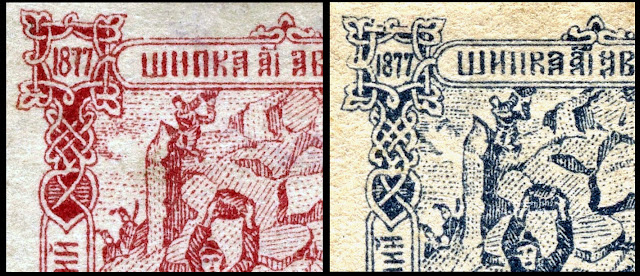 |
| Eagle's Nest Battle - Alexey Popov, 1893 |
On the 25th anniversary, a lithographed set of the the battle at Eagle's Nest was issued in 1902.
Although several battles occurred at Shipka Pass the stamps commemorate the Second Battle on August 26th between General Stoletov with 7,500 troops, and Suleiman Pasha with 38,000 Ottomans.
A Bulgarian bayonet charge repulsed the Ottomans.
When the Bulgarians were out of ammunition they threw rocks and boulders at the attackers.
Genuine Stamps
Forgeries
Older collections are more likely to have forgeries than genuine stamps.
The standard theory is that N. Imperato of Genoa, Italy created the forgeries but that may have been some 15-20 years after the originals appeared.
'Billig's grosses Handbuch der Falschungen' describes two different forgeries of the Shipka Pass series.
The story is that the Type I forgeries were made in large quantities as postal forgeries (counterfeits) at the end of 1902 by a group lead by an artillery officer named Bukowsky, who got the necessary equipment from the artillery laboratory in Sofia.
The forgeries were sold through regular stamp retailers, and caused great losses for the Bulgarian post.
Type II forgeries were made a few years later in Constantinople, and have poorer quality. In contrast to Type I these forgeries were made for sale to collectors.
Perhaps there is a connection between Imperato and Bukowsky with Imperato distributing them to the packet trade?
 |
| 3 Type I Forgeries |
Type I Forgeries
A comparison of the main differences with originals
Genuine left, Type I forgery right
In the forgery;
- The soldier on the left behind the rocks has a partial sword- The woven frame lines are thicker
- The 1877 is shorter
- The a's in the top frame have rounded instead of flat tops
- The soldier's head throwing the rock is tilted
- The 2 P's in the left frame are broken
- The gun being fired is further away from the bayonet and the rays are shorter
- The fingers of the dead soldier are different and not as well defined.
- The weaving lines are thick
- The foot of the 2 appears to be compressed
- The last H like character is extended and appears to bend
Type II Forgeries
I did not find that these were as common as the Type I
- A key feature is the perf hole size which is larger than the original or Type I forgery- The central design is more consistent with the original than the Type I.
- The dates on top are almost illegible
- Overall the letters are not well executed
- The weave pattern is very crude
- The stamp is more heavily shaded
References
Handbuch Bulgarien, Postwertzeichen 1879-1944 - R. Weinbrecht
Klaseboer Forgery CD 2 - 2019
Billig's grosses Handbuch der Faelschungen, Part 34, Vienna, 1937
The Serrane Guide - F. Serrane
Members from several Stamp Forums
A special thank you to James Jackson the creator of Big Blue 1840-1940 for providing several images










A good article but begins with a factual mistake. The battle for the Shipka Pass took place on 23 August 1877, not 1887.
ReplyDeleteThank you - corrected
Delete